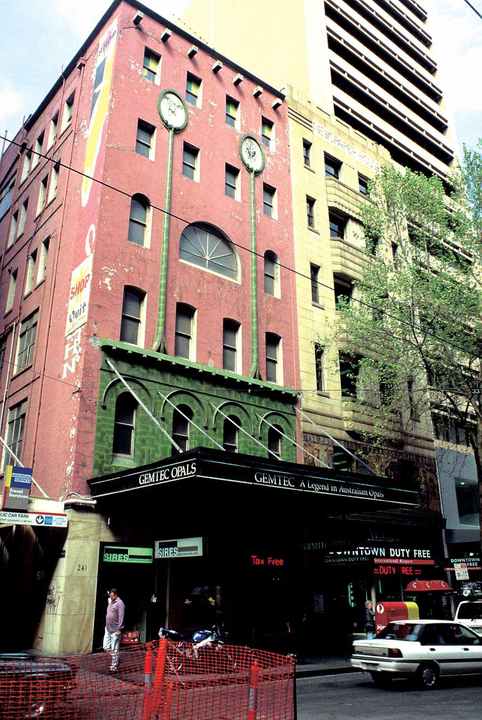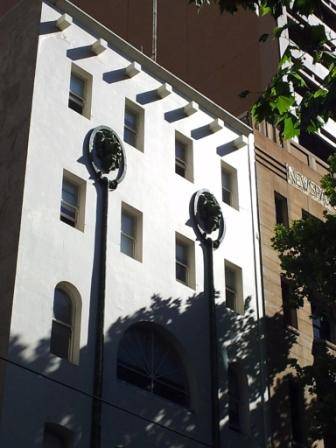| Back to search results » | Back to search page » |
|
Former Fourth Victoria Building
Location241 - 245 Collins Street,, MELBOURNE VIC 3000 - Property No B6382
File NumberB6382LevelState |
|
Statement of Significance
What is significant? The Fourth Victoria Building was originally a brick warehouse, built in1884 and remodelled in 1912 by architect Robert Haddon for its new owner, the Fourth Victoria Building Society. The eastern facade of the 1880s brick building was preserved along Manchester Lane, but Haddon stripped the Collins Street facade, rendered it with white cement, and added a series of whimsical decorative elements. Haddon's treatment of this facade reflected his interest in the Arts and Crafts movement, in nature, and in the latest architectural movements in Europe, and it is an early landmark of the modern movement in Victoria. The Fourth Victoria Building is also one of a particularly fine group of early twentieth century buildings in this part of Collins Street. File note 24/01/2013: Building renovated in 2008 as apartments, retaining original lift and re-instating lions' heads and original colour to the facade.
The six storey facadediffered significantly from other contemporary commercial facades in its austerity and originality. Above the ground floor shop front and awning the first floor facade is covered with a panel of green glazed tiles, originally with the name of building in large letters above arched windows, surmounted by a stylised wrought iron balcony. The facade above this was of plain white render pierced by windows without architraves. Above the fifth level were two large majolica medallions, originally containing green lions' heads, and trunk-like majolica elements dribbled from these down the facade. At the top was a simple parapet with a row of protruding beam ends below.
The interior was also remodelled in 1912, and the lift cage from this period is believed to still exist. The firm of Wunderlich Ltd, Victoria's major supplier of Edwardian pressed metal architectural features, particularly ceilings, which were so characteristic of the Edwardian period, was a supplier to the construction, and the first major tenant. As the building has been unoccupied for many years, it is likely that some at least of the original interiors, with their Wunderlich ceilings, survive.
The facade has since been altered only slightly: it has been painted pink and the lions' heads, which gave meaning to the form of the decoration and also proclaimed the purpose of the building, have been removed.
How is it significant? The former Fourth Victoria Building is significant for architectural and historic reasons at a State level.
Why is it significant? Architecturally the former Fourth Victoria Building is significant as a stylistically unique commercial facade, characteristic of its renowned architect and his idiosyncratic design technique, and his influence in turn from British Free Style architecture and the Viennese Secession. It was a very early, perhaps the only, commercial facade in Victoria to incorporate the simple white surface which was important in early twentieth century European modernism. The architect Robert Haddon considered that developing uniquely Australian forms and motifs was important, but in the design of this facade, rather than using Australian native motifs, he used overseas-inspired decorative elements, such as the Art Nouveau-inspired curvilinear forms, the lion motif, the white stucco wall and the protruding beam ends (deriving perhaps from the American Spanish Mission style) to create a striking and aesthetically satisfying composition.
Although the facade now lacks the two famous lions' heads of green glazed terracotta, its white surface, Art Nouveau elements, plain parapet and lushly tiled first floor level is remarkable for its contrast with contemporary commercial facades. The dripping majolica stems, stylised wrought iron balustrading and protruding beam ends at the cornice line provide a Secessionist character to the building, which housed tenants such as the Melbourne Bicycle Club, architects Vanheems and Isidore Beaver, and Leslie M Perrott in the 1920s, and appropriately a major tenant such as Wunderlich Pty Ltd, suppliers of architectural terracotta and pressed metal ceilings.
Historically it has significance for its associations with the architect Robert Haddon, and, in the opinion of Robin Boyd, is a landmark of the modern movement in architecture in Victoria.
Classified: 23/09/1992
Revised: 17/05/2004
Group
Commercial
Category
Office building





